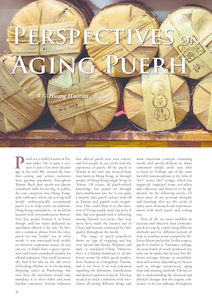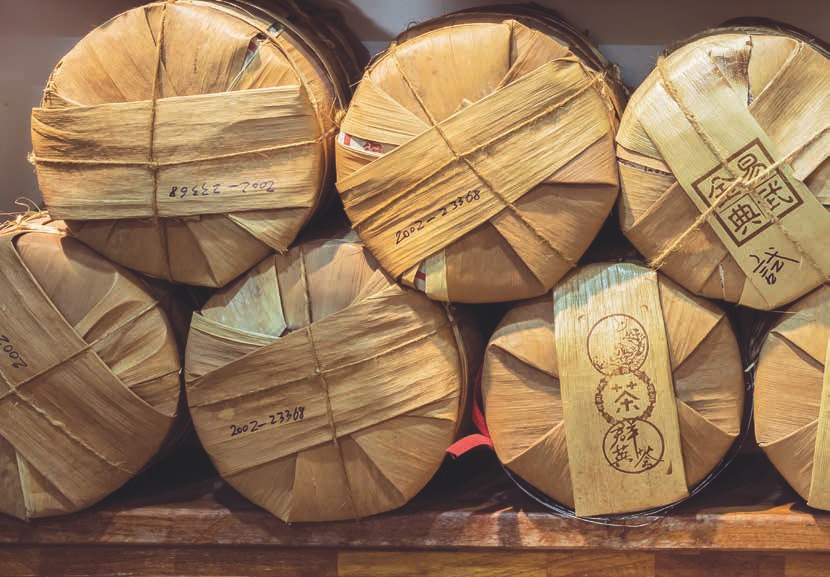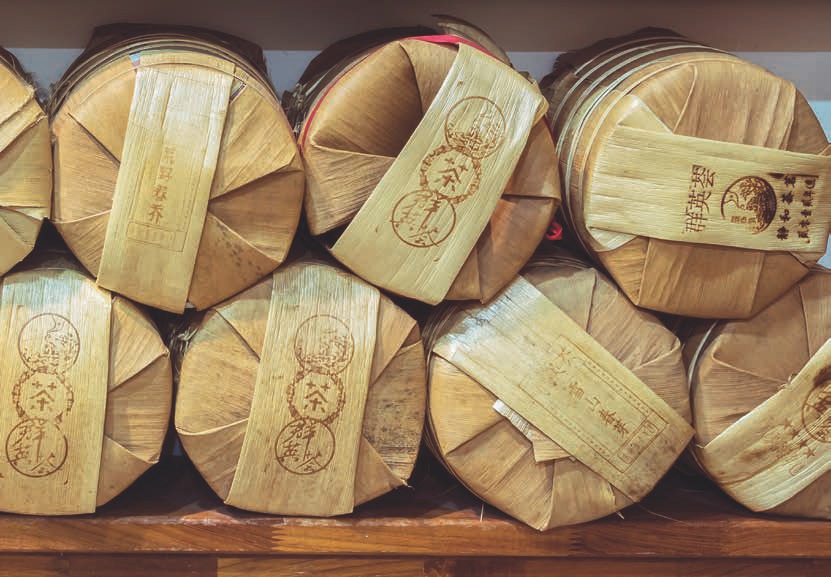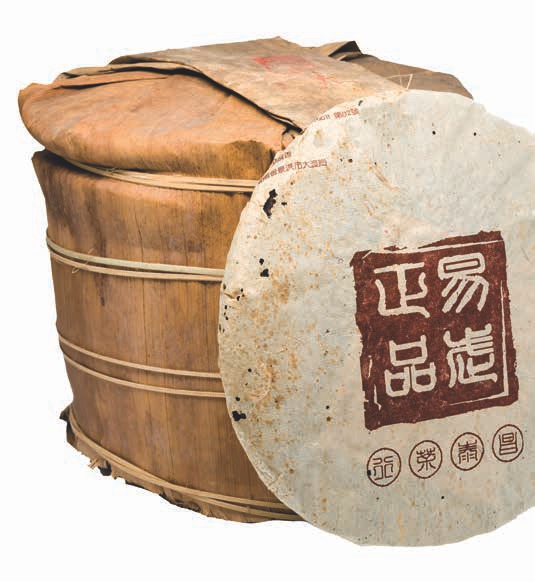
 |
|

Puerh tea is widely known in Taiwan today. This is quite a contrast to just a few short decades ago in the early 80s, around the time that oolong and artisan teahouses were gaining popularity throughout Taiwan. Back then, puerh was almost considered unfit for serving in public; the one exception was Hong Kongstyle teahouses, where the serving staff would enthusiastically recommend puerh tea to help create an authentic Hong Kong atmosphere - it would be scented with chrysanthemum flowers. Very few people brewed it at home though, and not many dedicated tea merchants offered it for sale. To borrow a common phrase from the time, puerh tea was "stinky" tea; in other words, it was associated with moldy or otherwise unpleasant scents. As you can see, it didn't have a great reputation, and wasn't considered suitable for refined teahouses. One could occasionally find it for sale on the old streets of Keelung Harbor or in the Juejiang shopping center at Kaohsiung, but even then the merchants would only introduce it to their oldest and most familiar customers. Artisan teahouses that offered puerh were even scarcer, and few people in tea circles had any experience of puerh. All the puerh in Taiwan at the time was sourced from merchants in Hong Kong, or through people of Hong Kong origin living in Taiwan. Of course, all puerh-related knowledge was passed on through these middlemen too. So, it was quite a surprise that puerh culture took off in Taiwan and gained such recognition. One could liken it to the situation of Yixing purple-sand clay pots; if they had not gained such a following among Taiwan's tea circles, they may never have made the journey out of China and become renowned for their quality throughout the world.
This surge in puerh popularity shows no sign of stopping, and has even spread into Korea, Malaysia and back to mainland China. However, there is a hidden drawback to all this fervor: across the whole puerh market, from Yunnan to Guangzhou, Taiwan, and so on, there is no real consensus regarding the definition, classification and desired qualities of puerh. This has resulted in much confusion, with merchants all saying different things and some important concepts remaining murky and poorly defined, so many consumers simply aren't sure who to listen to. Perhaps one of the most harmful misconceptions is the idea of "wet" versus "dry" storage, which has negatively impacted many tea sellers and collectors, and deserves to be addressed. In the following article, I'll share some of my personal thoughts and learnings that are the result of many years of research and experimentation with both puerh and oolong teas.
First of all, we must establish an accurate and objective basic principle: puerh tea can be stored using different methods and for different periods of time to produce many completely different flavors and styles. In this respect, puerh is similar to Taiwanese oolong: the same batch of newly produced maocha can be made into at least five different oolongs, distinct in mouthfeel, taste and aroma, depending on factors such as storage temperature, aging time and roasting methods. The key to this is understanding the chemical and physical changes that the organic substances in the tea undergo throughout this process. The difference between oolong and puerh is that the changes in oolong take place using "fire" (radiant heat or hot air) as a catalyst, whereas puerh makes use of the natural environment. So, we should avoid being reductive or narrow in our vision of puerh tea, and instead, we must approach it with an open mind and a sense of reverence, with an intent to explore and understand. So, what exactly are the influences of vintage, aging time and environment on puerh? Do you have a preferred vintage? Or, like me, do you find that puerh teas from all different vintages have their own unique character and worth, provided they are stored suitably and brewed at just the right temperature?
The second factor, which is the most important and the most difficult to understand, is storage: how should one best store puerh to age it to perfection? Can you just store it any old way, or must you follow the "dry storage" method that's popular these days? And what exactly is this "dry storage" method, anyway? Does it really mean that even a little humidity is unacceptable during aging? This can be quite perplexing for tea sellers and consumers alike. I was also confronted with this during the early days of my puerh research, and I often wondered why applying the theory of aging oolong tea to puerh leaves had completely the opposite result to the desired one - after all, both varieties are still tea leaves, aren't they? It wasn't until I later recognized the interconnection of two related chemical processes in puerh tea - oxidation in the leaves and fermentation caused by aspergillus mold - that I finally understood the complexity of "post-fermentation" in puerh. It isn't just one process or the other, but rather, the two interact differently in different environments, to trigger a series of complex chemical changes.
So, to decide how to store your puerh, you first need to understand the principles behind its fermentation, as well as what state the tea is presently in; then, you also need an idea of what direction you'd like the tea to develop in, to achieve the desired flavor. Since it's a very broad topic, and I only have the space of one article, I'll stick to explaining the theory of fermentation in puerh, and sharing a simple method for storing new sheng puerh.

As a simple way of explaining post-fermentation in puerh, let us turn to a useful analogy that will help us analyze this complicated topic: the "bicycle theory." In order to be quick and energy-efficient, a bicycle must fulfill a few basic conditions:
Of course, in reality the fermentation of puerh is a lot more complex than this analogy can express, but it's still useful as a simple comparison for the overall process. In our analogy, the front wheel represents fermentation caused by aspergillus fungi, while the back wheel represents fermentation due to oxidation within the leaves. The "chain" that sets off their interaction, then, is the temperature and humidity of the storage environment.
First, let's talk about the fermentation that is triggered by aspergillus mold. This is fermentation in the standard sense that most people are familiar with that takes place in alcohol, miso and other fermented foods. This process relies on the outside influence of a fungus (yeast, for example) to act on the carbohydrates in the food. For this type of fermentation, controlling the temperature and humidity of the surrounding environment is extremely important. Without sufficient heat and humidity, it's impossible to achieve a sweet, flavorful product. Puerh tea is no exception. Humidity is particulary important, as a certain degree of humidity is required to activate the fungi from the surrounding air, or the microorganisms present in the tea leaves since the manufacturing process, and allow them to reproduce. The secretions of these various fungi (the bulk of which are aspergillus molds) transform the organic substances in the tea - such as amino acids, cellulose, starch and pectin - into monosaccharides and then polysaccharides, giving puerh its rich, deep flavor.
While the tea is undergoing fermentation from these fungi, the polyphenols in the tea are also undergoing their own process of fermentation - that is, oxidation. As the fungi in the tea metabolize, they produce heat, and the heat, in turn, speeds up their growth. As this cycle intensifies, it causes the polyphenols to begin oxidizing. On top of this, the black aspergillus mold present among the fungi secretes an enzyme called polyphenol oxidase, which causes the polyphenols to undergo oxidative polymerization - in other words, further oxidation. These dual influences trigger a whole array of changes in the organic compounds in the tea, which bring out a pungent, vegetal aroma. Then, compounds such as amino acids and beta carotene, the "pioneers" of fragrance in tea, continue to oxidize and change the aroma still further. This is why puerh is known for becoming richer and more fragrant as it ages.
This is the difference between puerh and other kinds of tea - puerh needs a certain amount of humidity for these chemical changes to take place; whereas, with other teas, such as oolong, it's the exact opposite: humidity must be avoided at all costs. If you stored oolong in the manner of puerh, exposed to the air or some degree of humidity, after a while, the tea would become sour and astringent, and the liquor cloudy. Left even longer, the flavor would become weaker and weaker, with more unintended, "messy" flavors. This is due to differences in the processing methods and in the tea leaves' DNA. The native Yunnan tea trees used to produce puerh are of the original large-leaf variety. Their leaves contain a special type of cell that aids the growth of beneficial fungi; under the right environmental conditions, this allows unique local varieties of fungi to flourish. The humidity is essential for these fungi to propagate.
So, we can conclude that humidity is vitally important for the proper post-fermentation of puerh. What would be the result if you took a newly produced sheng puerh and kept it for a few years in a cool, dry place? For this, we can return to our bicycle analogy: without humidity, our front wheel (the fermentation from those aspergillus molds) cannot start turning, so we'd be left to rely on the back wheel (that is, the oxidation of the polyphenols) to turn on its own. This results in the tea leaves taking on a brighter yellowish- or reddish-brown color, and as the leaves continue to lose moisture, the surface of the tea cake hardens and the aroma changes from a vegetal scent to a sweeter fragrance. The tea leaves become more tightly coiled, and, at first glance, it looks as if the tea will be even nicer for drinking - but in reality, the result is quite the opposite. The color of the liquor is bright and clear, but the tea lacks nutrients. At first taste, the liquor is slightly sweet, but not sweet enough to have the proper appeal, and when the tea cools down, it becomes quite astringent.
If the tea is stored in these conditions for even longer, more than ten years, for example, the color of the tea will become darker and redder; the flavor, on the other hand, will grow more and more insipid. This is because when tea is stored under these conditions, the heat in the surrounding atmosphere is not sufficient to raise the temperature of the tea leaves and trigger the oxidation of the organic compounds in the tea, and all those simultaneous physical and chemical changes that we discussed are unable to happen the way they should. Instead, the amino acids and carbohydrates in the leaves are consumed as "fuel" in the reactions that do take place, which is a great waste of the beneficial organic compounds in the tea. According to our bicycle theory, we could compare this to a bike whose back wheel is too large - this causes the front wheel to stop moving. Just how is one supposed to pedal such a bike and get the wheels revolving as they should? My sincere hope is that you, reader, may gain some insight from this analogy and save yourself the heartache of wasting your tea and effort due to unsuitable conditions!
Now that we've discussed what not to do, what are the ideal conditions for storing puerh? It's important not to lump all puerh teas into one category here, because there are many kinds and stages of puerh. However, for newly produced sheng puerh in particular, here are some basic recommendations:

Over time, a puerh lover learns some lessons the hard way. One of the best pieces of advice we wish we could impart to our younger selves starting out on a tea journey is, as Wu De often says, "hit it hard!" When you find a puerh you like, buy lots. This means that you should know your tea budget and devote some percentage of it to aging tea for your future - your retirement in tea bliss. Otherwise, you will find that teas you love always go up in price over time. You buy a cake, drink it all, and then return to the tea shop to get a second, only to find the price has doubled. You think that is too much and buy something else instead. Then, years later, your friend makes that same tea for you again and you are blown away, determined to buy another, even if it is double. But, alas, now the price has quadrupled and you feel like shooting yourself in the foot for not buying five cakes when it was only double. Enough of such experiences and you learn to "hit it hard!"
Traditionally, puerh lovers always buy at least a tong (筒) and a cake. A tong is seven cakes of puerh wrapped up in bamboo skin. Bamboo and tea have been married for centuries. Bamboo is odor free and protects tea. It has been used to store different kinds of tea all throughout China. The bamboo skin will protect your puerh from excessive humidity and mold, as well as disasters, like collapsing shelves, flooding, etc.
The reason puerh lovers buy at least a tong and a cake of teas they enjoy has to do with the way puerh tea ages. Through many experiments, tea lovers have found that puerh tea ages much better compressed in cakes than loose leaf. Loose-leaf tea is exposed to more oxygen and gets too humid easily. Also, the steaming and compressing creates the perfect environment for the microorganisms to do their work. But aged puerh is so much better when it is broken up. In the October 2015 issue of Global Tea Hut, Shen Su did the experiment of tasting broken versus compressed puerh. After the tea has reached a desired level of fermentation, it is always advisable to break it up and store it in a jar for at least a couple weeks before drinking. This exposes the inside to air and gives the tea breadth, making it more full-bodied and aromatic.
As you can see, a cake which you drink from is therefore not ideal for storage or drinking: storage because breaking into it compromises the environment and speeds up fermentation, and not ideal for drinking because puerh cakes are better broken up. And this is why we traditionally buy a tong and a cake. The extra cake can be like a scrap cake that you taste every few years just to see how the tea is aging and make a decision on when you want to start enjoying your aged puerh cake. After enough years have passed, you return to this eighth, scrap cake and decide that the time has come - the tea has reached the desired level of fermentation. At this point, you can take a cake out of the tong you have in storage, protected so nicely by the bamboo skin, which closes back up neatly over the remaining cakes, and break that cake up to store in a jar for a few weeks before drinking. If you want a gap between when the jar is empty and the time you break up the second cake from the tong, you can always return to your extra scrap cake again to decide when that should happen. Take our advice and buy a tong and a cake of the puerh teas which really speak to you!
Of course, some of us may have trouble achieving all of these conditions - with the outrageous housing prices in Taipei, for example, even the most dedicated Chajin would be hardpressed to find a separate space in their house just for storing tea! On the other hand, Taiwan's humid, subtropical climate means that no matter if you're in the north or south, at least one-quarter of the days in the year will be hot and humid. So those of you in Taiwan can simply put your batches of tea in cardboard boxes and place them in a cupboard or basement.
If you're storing the tea in an open room, remember to keep it away from windows - the corner of the room is a good choice. Avoid turning on the air-conditioning if possible - there's no harm in letting the indoor temperature and humidity vary according to the weather outside. It's best to seal the cardboard box up, with no holes or openings. After being kept like this for three to five years, the tea will have changed substantially, with the astringency and sharpness of the new tea mellowing out considerably. The tea will take on a sun-baked aroma that evolves into a subtly sweet, fruity fragrance, and the liquor will be amber or light brown in color. The flavor will become sweeter and smoother, and the overall composition of the flavor will show a pleasing development. Once a puerh displays all these signs, it has completed the first step of post-fermentation, which will form a solid foundation for further aging.
You can brew puerh at this stage in its maturation using medium-temperature water (90 °C or so), which will produce a sweet, refreshing liquor. Or, you can consider letting the tea continue to ferment in the same location or move it to a different place with a fairly high temperature, to allow continued aging and oxidation to further change the composition of the flavor. You can choose how to adjust the process based on your own tastes.
So, in summary, the changes that puerh undergoes during post-fermentation are many and complex, and certainly can't be conveyed in just a few words. This article is but a brief outline of the general principles - an offering of a small portion of my own learnings on puerh. My main goal is to clear up the confusion surrounding "wet" and "dry" storage, and to provide some clarity on the steps in the post-fermentation process. It's important for us, as lovers of tea, to understand this, as mistakes in selecting the storage environment could mean wasting much time and money; even ten or twenty years on, when we ourselves are showing some signs of aging, we might still never get to enjoy a cup of truly great puerh! It is also my heartfelt wish that you, puerh lovers, not be content with just reading the packaging and listening to what other people tell you; but rather, that you might put in some more time and thought to research and observe puerh's changes for yourself, and experience its differences and subtleties. Just think: if you start with the same puerh tea, you can speed up its evolution, or shorten aging time, and get different results, simply by changing the environment. In the life of a tea lover, is this not a wonderful thing?

